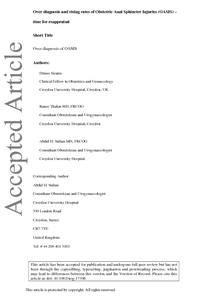Sioutis, D; Thakar, R; Sultan, AH
(2017)
Overdiagnosis and rising rate of obstetric anal sphincter injuries (OASIS): time for reappraisal.
Ultrasound Obstet Gynecol, 50 (5).
pp. 642-647.
ISSN 1469-0705
https://doi.org/10.1002/uog.17306
SGUL Authors: Sultan, Abdul Hameed
![[img]](https://openaccess.sgul.ac.uk/108905/1.hassmallThumbnailVersion/Sioutis_et_al-2016-Ultrasound_in_Obstetrics_%26amp%3B_Gynecology.pdf)  Preview |
|
PDF
Accepted Version
Available under License ["licenses_description_publisher" not defined].
Download (1MB)
| Preview
|
Abstract
OBJECTIVES: To identify the accuracy of clinically diagnosed OASIS using 3D endoanal ultrasound and compare symptoms and anal manometry measurements between those whose anal sphincters were adequately repaired to those who had persistent anal sphincter defects. METHODS: The endoanal scan images of women who sustained OASIS and attended the perineal clinic over a 10 year period (2003 - 2013) were re-analysed from data entered prospectively of women with clinically diagnosed and repaired OASIS. The St Mark's Incontinence Score (SMIS) as well as anal manometry measurements were included in the analysis. RESULTS: The images of 908 women were re-analysed. We found that there was no evidence of OASIS (Group A) = 64 (7%); external anal sphincter (EAS) scar alone (Group B) = 520 (57.3%); anal sphincter defect (Group C) = 324 (35.7%). Of the 324 women with a defect, 112 had an EAS defect and 90 had an internal anal sphincter (IAS) defect and 122 had a combined IAS + EAS defect. The SMIS was significantly higher in women with a defect (p = 0.018) but there was no significant difference in scores between women with an intact sphincter and women with a scar. Compared to the intact group, both the maximum resting (median and range [55 (29-86) vs 43.5 (8-106) mmHg; p < 0.001] and maximum squeeze pressures [103 (44-185) vs 73.5, (23-180); p < 0.001] were significantly lower in women with a defect but less so with a scar. The anal length was significantly shorter in woman with a defect [25 (10-40) vs 20 (10-40) mm]. CONCLUSIONS: Seven percent of women who had a clinical diagnosis of OASIS were wrongly diagnosed as they only had a second degree tear. We believe that this rate may differ from other units but training methods and competency assessment tools for the diagnosis and repair of OASIS need urgent reappraisal. The role of anal ultrasound in the immediate post-partum period needs further evaluation as it will be dependent on the expertise of the staff available to accurately interpret the images.
| Item Type: |
Article
|
| Additional Information: |
This is the peer reviewed version of the following article: Sioutis, D., Thakar, R. and Sultan, A. H. (2017), Overdiagnosis and rising rate of obstetric anal sphincter injuries (OASIS): time for reappraisal. Ultrasound Obstet Gynecol, 50: 642–647, which has been published in final form at http://doi.org/10.1002/uog.17306. This article may be used for non-commercial purposes in accordance with Wiley Terms and Conditions for Self-Archiving. |
| Keywords: |
OASIS, anal sphincter, endoanal ultrasound, third degree tears, Obstetrics & Reproductive Medicine, 1114 Paediatrics And Reproductive Medicine |
| SGUL Research Institute / Research Centre: |
Academic Structure > Institute of Medical & Biomedical Education (IMBE) |
| Journal or Publication Title: |
Ultrasound Obstet Gynecol |
| ISSN: |
1469-0705 |
| Language: |
eng |
| Dates: |
| Date | Event |
|---|
| 5 November 2017 | Published | | 19 September 2016 | Published Online | | 13 September 2016 | Accepted |
|
| Publisher License: |
Publisher's own licence |
| PubMed ID: |
27643513 |
 |
Go to PubMed abstract |
| URI: |
https://openaccess.sgul.ac.uk/id/eprint/108905 |
| Publisher's version: |
https://doi.org/10.1002/uog.17306 |
Statistics
Item downloaded times since 13 Jun 2017.
Actions (login required)
 |
Edit Item |



